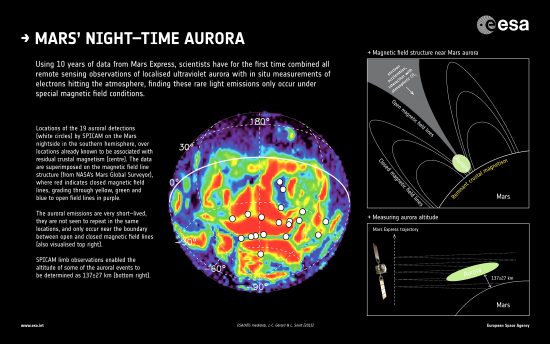Aug 30, 2018
The MAVEN Mission continues in orbit around Mars.
Mars is approximately 6793 kilometers in diameter, about half that of Earth, with a substantially lower average temperature at minus 63 Celsius, compared to Earth at plus 13 Celsius. Atmospheric density on Mars is equivalent to standing on top of a mountain six times taller than Mount Everest, or less than 1% that of Earth. It is so cold that planetary scientists believe that it is covered with a planet-wide layer of permafrost, because the annual mean temperature of the soil is so low.
In the northern and southern latitudes, carbon dioxide freezes into a solid, burying the terrain in dry ice. That is what finished the Phoenix mission to Mars: the lander was encased in almost a meter of dry ice during the winter. Since the atmosphere is so thin, water-ice sublimes directly into vapor, so there can be no ice or water out in the open. How did Earth and Mars diverge so dramatically?
Sounds like a straightforward question. However, those eight words are among the most puzzling in planetary science. The consensus view sees evidence that Mars once hosted liquid water flowing over the surface. What look like valleys and water-carved canyons are everywhere. The Curiosity Rover found minerals that require years underwater to form. However, over all, there are few carbonate compounds in abundance, not nearly enough to account for the missing carbon dioxide that must have once existed in the atmosphere.
They are left with only one suggestion: the atmosphere must have leaked away over the eons. In part, the latest Mars orbiter, MAVEN, is studying how it happened and what force might drive the escape. Was it solar radiation—the solar wind—that scrubbed away the atmosphere, because Mars lacks an intrinsic, global magnetic field? How much total atmosphere escaped?
The Mars Atmosphere and Volatile Evolution Mission (MAVEN) was launched on November 18, 2013 and entered orbit around Mars in September 2014. It was originally planned for a single year of operations, but it continues to be financed, adding to other long-lived Martian missions. MAVEN is studying the ionosphere on Mars, and how it interacts with the solar wind, along with ultraviolet light effects from the Sun on the upper atmosphere.
Data from MAVEN indicates that Mars is losing its atmosphere at a rate of about 100 grams per second, or about 3,100,000 kilograms per year. The research team believes that Mars was once like Earth until the internal dynamo cooled-off and solidified, leaving no liquid metallic iron to generate an all-encompassing magnetic field. Their idea is that Earth will resemble Mars in about 5 billion years. Once its core is solidified, it will be unable to maintain its shield against solar wind ions. However, since Earth and Mars are thought to be siblings, born from the same planetary nebula at roughly the same time, what caused Mars to cool?
Stephen Smith













